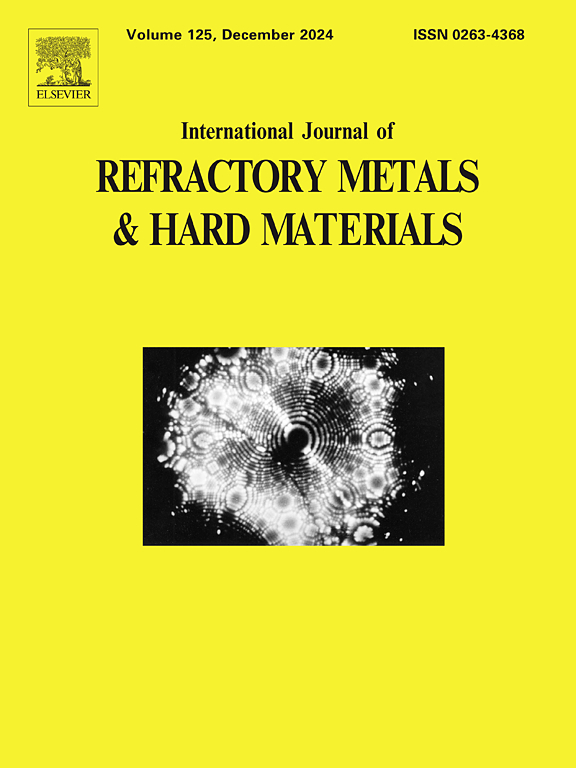退火温度对Nb521Y合金取向形核和选择性生长的影响
IF 4.6
2区 材料科学
Q2 MATERIALS SCIENCE, MULTIDISCIPLINARY
International Journal of Refractory Metals & Hard Materials
Pub Date : 2025-06-24
DOI:10.1016/j.ijrmhm.2025.107301
引用次数: 0
摘要
铌(Nb)是空间核反应堆热管的候选材料,在高温下使用会发生再结晶。再结晶通常伴随着织构的演变,织构的演变与材料的力学性能和抗辐照性能有关。因此,有必要研究再结晶过程中织构的演变机制。将变形后的Nb合金Nb521Y在1100、1150、1200、1250、1300、1350和1400℃下退火1 h,再结晶温度为1300℃。退火过程中,发生了取向形核和选择性生长,两者都表现出温度依赖性。再结晶成核通过应变诱导的晶界迁移和亚晶聚结发生,起源于变形的晶界和亚晶网络。变形Nb521Y呈现{001}< 110 >、{112}< 110 >,特别是{111}< 110 >织构。{111} < 112 >、{110}< 100 >和{001}< 110 >取向成核,后两者在温度高于1150℃时才开始成核。1250℃退火后,依次出现{111}< 112 >、{225}< 5-54 >和{115}< -3-72 >的选择性生长。1300℃退火后,首先发生{111}< 112 >的选择性生长,然后发生{111}< 112 >的{110}< 100 >和{331}< 1 ~ 10 >的生长。选择性生长顺序及其对退火温度的依赖关系与取向角有关,其中接近30°的取向角在较低温度下更有利于生长。本文章由计算机程序翻译,如有差异,请以英文原文为准。
Oriented nucleation and selective growth dependence on annealing temperature for Nb521Y alloy
Niobium (Nb) is a candidate material for heat pipes in space nuclear reactors, and it would suffer recrystallization when used at high temperatures. Usually, recrystallization is accompanied by texture evolution, which is related to mechanical properties and irradiation resistance. Thus, it's necessary to evaluate the texture evolution mechanism during recrystallization. In this work, a deformed Nb alloy named Nb521![]() Y with 70 % reduction was annealed at 1100, 1150, 1200, 1250, 1300, 1350, and 1400 °C for 1 h, and then the recrystallization temperature was determined as 1300 °C. During annealing, oriented nucleation and selective growth occurred, both of which exhibited a temperature dependence. Recrystallization nucleation occurs via strain-induced boundary migration and sub-grain coalescence, initiating at deformed grain boundaries and sub-grain networks. The deformed Nb521
Y with 70 % reduction was annealed at 1100, 1150, 1200, 1250, 1300, 1350, and 1400 °C for 1 h, and then the recrystallization temperature was determined as 1300 °C. During annealing, oriented nucleation and selective growth occurred, both of which exhibited a temperature dependence. Recrystallization nucleation occurs via strain-induced boundary migration and sub-grain coalescence, initiating at deformed grain boundaries and sub-grain networks. The deformed Nb521![]() Y presented {001} 〈110〉, {112}〈110〉, especially {111}〈110〉 textures. Oriented nucleation of {111} 〈112〉, {110} 〈100〉, and {001}〈110〉 occurred, and the latter two were nucleated until temperatures were above 1150 °C. After 1250 °C annealing, selective growth of {111}〈112〉, {225}〈5–54〉and {115} 〈–3–72〉occurred in sequence. After 1300 °C annealing, selective growth of {111}〈112〉 also occurred firstly then growth of {110}〈100〉 and {331} 〈1−10〉 from {111}〈112〉took place. Selective growth sequence and its dependence on annealing temperature were related to misorientation angles, of which close to 30° were preferred to grow at lower temperatures.
Y presented {001} 〈110〉, {112}〈110〉, especially {111}〈110〉 textures. Oriented nucleation of {111} 〈112〉, {110} 〈100〉, and {001}〈110〉 occurred, and the latter two were nucleated until temperatures were above 1150 °C. After 1250 °C annealing, selective growth of {111}〈112〉, {225}〈5–54〉and {115} 〈–3–72〉occurred in sequence. After 1300 °C annealing, selective growth of {111}〈112〉 also occurred firstly then growth of {110}〈100〉 and {331} 〈1−10〉 from {111}〈112〉took place. Selective growth sequence and its dependence on annealing temperature were related to misorientation angles, of which close to 30° were preferred to grow at lower temperatures.
求助全文
通过发布文献求助,成功后即可免费获取论文全文。
去求助
来源期刊
CiteScore
7.00
自引率
13.90%
发文量
236
审稿时长
35 days
期刊介绍:
The International Journal of Refractory Metals and Hard Materials (IJRMHM) publishes original research articles concerned with all aspects of refractory metals and hard materials. Refractory metals are defined as metals with melting points higher than 1800 °C. These are tungsten, molybdenum, chromium, tantalum, niobium, hafnium, and rhenium, as well as many compounds and alloys based thereupon. Hard materials that are included in the scope of this journal are defined as materials with hardness values higher than 1000 kg/mm2, primarily intended for applications as manufacturing tools or wear resistant components in mechanical systems. Thus they encompass carbides, nitrides and borides of metals, and related compounds. A special focus of this journal is put on the family of hardmetals, which is also known as cemented tungsten carbide, and cermets which are based on titanium carbide and carbonitrides with or without a metal binder. Ceramics and superhard materials including diamond and cubic boron nitride may also be accepted provided the subject material is presented as hard materials as defined above.

 求助内容:
求助内容: 应助结果提醒方式:
应助结果提醒方式:


